 Most viewed - Vintage Postcards Most viewed - Vintage Postcards |

Oiran courtesan. Also see my photos of an oiran show here. My oiran video at YouTube here.4071 viewsThe highest-ranking geisha is called an oiran or tayu. She is escorted by two little attendant girls called kamuro. Notice her high clogs. It takes some skill to walk in those and she usually requires someone's shoulder to hold onto while walking. Sometimes at festivals or special events, you can see the Oiran Dochu procession where she walks in a parade together with geisha attendants.
|
|
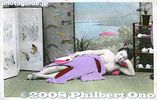
Nude woman lying down2169 views
|
|
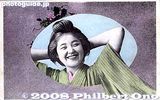
Out of all the geisha that have appeared on postcards, this ever-smiling geisha was unsurpassed in popularity. Her smiling visage appeared in 40 to 50 different poses in photographs and postcards made in Yokohama from the 1890s.2047 views
|
|
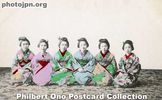
Brothel maids or prostitutes. Maids were employed to guide patrons to their rooms and serve sake and food. Or they could be low-class (cheap) prostitutes. Hand-colored, undivided back.1530 views
|
|
|
|
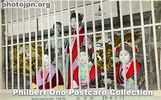
Shin-Yoshiwara prostitutes. They are sitting behind the "cage" which fronted the street for all to see (and choose) within the licensed quarters. Shin-Yoshiwara was a famous red-light district of Tokyo. Note that they are not geisha.991 viewsGeisha were not prostitutes. This photo was taken during 1907-1911. The woman in the far back was the brothel's matron who supervised this live display and everything else. In 1912 when Emperor Meiji died, this live display of women was later replaced by framed photographs of each woman hung near the brothel's entrance. In 1958, prostitution was outlawed in Japan, and Yoshiwara was history.
|
|

Flower arrangement. She's about to put the flower into the vase made of bamboo. On her lap, there's a pair of scissors used for flower arrangement. Her purple kimono has a design showing wisteria flowers. The season must have been spring.921 viewsThe card was printed in color so it's not that old.
|
|

Japanese Beauty. I would call this a representative example of a "Nihon Bijin" or Japanese Beauty photograph. She's posed formally, dressed in a kimono, and looking serene and attractive. She might bJe a geisha. Hand-colored, and undivided b912 viewsI bought it for 1,200 yen.
|
|
|
|
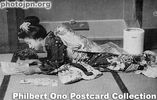
Maiko in Her Room834 viewsA private moment. This maiko is lying down in her kimono reading a comic book after getting tired of playing cards. Her mama-san probably would not be pleased to see her wrinkle the kimono like that. Not sure if this was staged or a candid shot. It's hard for anyone to lie down like that in a kimono.
|
|

Girl with Umbrella. Hand-colored postcard dating before 1918. The kimono looks like casual wear, and the design pattern was typical during the turn of the 20th century. She's still in her teens it seems. One of the first vintage postcards I bought. Y2827 views
|
|

Swimsuit Beauties. These are typical swimsuits worn during the late 19th century. Horizontal stripes were in vogue. They are not posed very well, but there's something charming about them. This postcard is postmarked Aug. 1912. A nice summertime greet822 views
|
|
|
|

Swimsuit pin-up. Another picture that makes you laugh. Apparently she felt sexy in that suit and knew how to pose like a pin-up swimsuit model.768 views
|
|
|

761 views
|
|

Laughing Geisha with umbrella. As you may have noticed, the umbrella (and fan) was a commonly used prop in tourist photos. Postmarked 1903 from Yokohama. The actual card is more yellowed and almost brown, but I bleached it with Photoshop.722 views
|
|
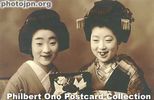
Geisha and maiko712 viewsNot a good photo, but their names are written in hiragana on the back. They read "Suimatsu" on the left and "Shigezuru" on the right who is a maiko, not geisha. She has more ornaments in her hair than the geisha. Also notice their blackened teeth. If they are in Kyoto, a geisha is called "geiko." In Tokyo, a maiko (apprentice geisha) is called "hangyoku." This is a postcard-size photo and not a postcard.
|
|

Beauty with fan. The white space around her was for writing the correspondence. You could not write the message on the same side as the address. The back of the postcard was for the address only.669 viewsSo it has an undivided back, which means there is no dividing line between the address side and correspondence side, Postcards with an undivided back were made between 1900 and March 28, 1907. That's how we know the approximate age of this card even though it has no postmark.
|
|

Commodore Perry Landing Monument. The Perry monument at Kurihama on the Miura Peninsula (Kanagawa Pref.) was built on July 14, 1901. It marks the spot where he first landed in Japan in 1853.662 viewsClick to see what the monument looks like today. I wonder what happened to it during the World War II. Was it destroyed or left untouched? This postcard was made to commemorate the visit of the US Fleet in Oct. 1908.
|
|

592 views
|
|

Woman with pen and scroll. Judging from her hairstyle, this photo was probably taken during the Taisho Period (1912-1926).571 views
|
|
|

Geisha Pair Outside Geisha House. These two geisha know how to pose for the camera. It looks like Kyoto. You can tell that they are geisha because of the shorter kimono sleeve, subdued kimono design (mostly black), and their clogs (for rainy weather).558 views
|
|
|
|

Cherry Blossoms, Potomac Park, Washington, DC。. Postcard made in the USA in the late 1930s or early 1940s. It was in 1912 (the year the Titanic sank) when Viscountess Chinda, the wife of Japan's Ambassador to the U.S., gave 2,000 small cherry trees.533 viewsIt was in 1912 (the year the Titanic sank) when Viscountess Chinda, the wife of Japan's Ambassador to the U.S., gave 2,000 small cherry trees to Mrs. Helen Taft, the wife of President Willian Taft. In a quiet ceremony, Mrs. Taft and Viscountess Chinda planted the first two cherry trees along the Tidal Basin in Potomac Park in Washington, DC. These two trees still exist today, marked by a special plaque. .
To read more about the interesting history of these cherry trees, see the National Park Service's Web site on the Washington Cherry Trees. You can read about how the original shipment of 2,000 cherry trees from Tokyo in 1910 had to be destroyed upon arrival in the US due to the infestation of harmful insects and diseases.
|
|

Maiko with umbrella. The quickest way to tell if she is a geisha or maiko is by looking at her back. The tell-tale sign of a maiko is her long obi sash hanging down behind. Whereas the geisha's sash has a short knot instead.522 views
|
|

Teruha with chrysanthemum. The flower she's holding matches her kimono design that shows the same flower. Her name was Teruha and she appeared in many postcards. She was born in 1896 in Osaka and worked as a geisha in Shimbashi, Tokyo. Click to read m512 viewsTeruha with chrysanthemum. The flower she's holding matches her kimono design that shows the same flower. Her name was Teruha and she appeared in many postcards. She was born in 1896 in Osaka and worked as a geisha in Shimbashi, Tokyo before becoming a Buddhist priest in Kyoto. Read more about her interesting life by James A. Gatlin at geikogallery.com.
|
|
|
|

Poor posture and how not to pose in a kimono.478 views
|
|

Tres Flores. Intriguing pose. It looks like a modern postcard, but it's postmarked 1907!476 views
|
|
|
|
|

Woman on bicycle. That's a thick shawl she's wearing. Must've been winter. It's unusual to see a bicycle used as a studio prop. Riding a bicycle while wearing a kimono must have been difficult. The postmark looks like 1908. Hand-colored.463 views
|
|

In front of mirror. Hand-colored postcard sent as a Christmas card in 1914.453 views
|
|

Typical woman and flower. Give a woman a flower and ask her to pose with it, and this is how she typically would hold it.449 views
|
|
|
|
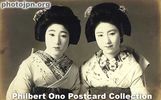
Pair of Geisha, autographed. One of my most treasured cards. This card was signed (on the chest area) by these two geisha with a fountain pen. Several other geisha also signed the back of the card. (See the next image.)441 views
|
|

Drawing of Commodore Perry, Grossly distorted if not humorous rendition of Commodore Perry by a Japanese artist who apparently never knew what Perry really looked like. It was drawn at a time when the Japanese thought all foreigners were barbarians.436 views
|
|

Two Patriotic Maiko. To cheer up the soldiers on the front line, pretty and smiling maiko (apprentice geisha) often appeared on postcards for military mail. This card was postmarked Aug. 1940 from Shizuoka city. It was not addressed to a soldier though.430 viewsBoth women are maiko and not full-fledged geisha yet. The sleeves of a maiko's kimono reaches toward the ground as you can see here. (The sleeves of a geisha is shorter.) The kimono design is also more colorful and gaudy. Maiko also wear clogs called pokkuri. They are wedged at the front, so if you are not careful, you can trip forward. Geisha do not wear pokkuri.
|
|

Laughing Geisha with low neck. She's almost semi-nude. It is probably her sexiest pose of all. A great summertime card and one of my favorites. Hand-colored and postmarked Feb. 25, 1908 in Yokohama. The actual card is more yellowed.429 views
|
|

Girl in Storm. Wires were used inside the kimono to make it look wind-blown like in a rainstorm. Even her clogs are for rain. Early photographers commonly imitated the poses and scenes depicted in ukiyoe woodcut prints and Nihonga paintings.427 viewsAlthough the photographer and model were serious in making this picture, it makes you laugh.
|
|
|

Mona Lisa Smile. She's cute, ideal for a passport photo. But her hairstyle is more striking than anything. What do you call it? A Westernized Japanese hairstyle?416 views
|
|

Naosuke Ii and Commodore Perry. Issued in 1909, this postcard commemorates the 50th anniversary of the opening of Yokohama Port. It has a commemorative postmark marking the "Jubilee of Opening of Yokohama Port."415 viewsYokohama Port was officially opened to foreign trade on July 1, 1859 in accordance with the US-Japan Treaty of Amity and Commerce.
The card honors Naosuke Ii and Commodore Matthew C. Perry. You could say that Japan-America relations started with these two men. Ii was the Tokugawa shogunate's Great Elder (Tairo) who favored and concluded commercial treaties with the Western powers and thus broke Japan's isolation from the world. Foreigners were then allowed to trade with Japan and take up residence in cities like Yokohama and Hakodate. Ii was later assassinated in 1860 by people who sought to oust the foreign "barbarians."
Commodore Perry first came to Japan in July 1853 with his four warships which the Japanese called "black ships" (kurobune). No diplomatic breakthrough was made, but Perry's knocking on Japan's door was heard loud and clear. Running low on provisions, Perry departed for China and promised to return to Japan which he did in Feb. 1854. This time he got what he wanted. The Treaty of Kanagawa was signed about a month later. The treaty allowed US ships to call on two ports: Shimoda (Kanagawa) and Hakodate (Hokkaido). Permission for a US Consul (Townsend Harris) to reside in Japan was also stipulated. Official diplomatic relations between Japan and America thus began.
|
|

Smiling for the camera. It's always nice to see a smiling woman on a vintage postard. This is not an ideal smile though. Kind of sheepish and unnatural. Sort of half-hearted and "halfway" like her fan which is only half open.408 views
|
|

Laughing Geisha with Basket. It looks like she's dressed for picking tea leaves. This card, which has an undivided back, dates before 1907. The actual card is more yellowed.407 views
|
|
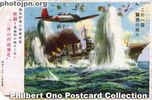
Wartime Mitsui Life Insurance ad card. Dated Feb. 1942, this advertising postcard shows a Japanese torpedo bomber dropping a torpedo aimed at a US battleship under heavy attack. An American flag (faint) can be seen on the ship's mast.405 viewsDated Feb. 1942, this advertising postcard shows a Japanese torpedo bomber dropping a torpedo aimed at a US battleship under heavy attack. An American flag (faint) can be seen on the ship's mast. The advertising copy reads, "This one shot is a phenomenal force." On the left, the text reads, "A new weapon for national savings." "Very low insurance premiums." "Mitsui's provision for old age" "It has no enemies!" For some reason, the left corners of the card were cut with scissors, perhaps to remove it from an album.
Needless to say, the lowest point in US-Japan relations was World War II. The Pearl Harbor attack, the internment of Japanese-Americans, battles at Midway and other Pacific islands, Tokyo fire bombing raids, land battle on Okinawa, and the nuclear bombing of Hiroshima and Nagasaki still reverberate among the generations today. Every year in August in Japan, ceremonies are held to mark and memorialize the Hiroshima and Nagasaki bombings and the war's end. All the while, Dec. 8 (7 in Hawaii) is just another day in Japan with no particular significance.
Of course in Hawaii, Dec. 7 is a day of national mourning as much as Hiroshima/Nagasaki Day in Japan. Each country mourns its own and neither seems to care about the other's war dead. I await the day when both countries mourn for each other as well as for themselves. After all, we all belong to the same family, the Family of Man.
|
|

Baby Baby Sitter. Such scenes were common in those days. Mom and dad were both busy farming, leaving the baby in the hands of older children. Hand-colored.399 views
|
|

Maiko on Gojobashi Bridge. Postcard-size real photo taken in Kyoto. She has been poorly posed. Her posture is bad, her kimono is ruffled, the sleeves look bad, and her feet are pointing in the wrong direction. Maiko usually know how to pose themselves.392 viewsPostcard-size real photo taken in Kyoto. She has been poorly posed. Her posture is bad, her kimono is ruffled, the sleeves look bad, and her feet are pointing in the wrong direction. Maiko usually know how to pose themselves for a photograph. But not this one. Perhaps she's an amateur.
|
|
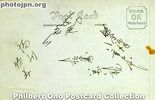
Pair of Geisha, autographed (back). This is the back of the preceding card. It looks like four geisha signed it.390 views
|
|

Woman with two flowers. She's holding the flowers in a cross or "X" mark. I wouldn't call that a good way to hold flowers (unless you're a hula dancer).385 views
|
|

Smiling Maiko Sitting. Real-photo postcard to cheer up soldiers. This card was sent as military mail from Kyoto on New Year's Day 1939. The kanji characters on the fan says "Banzai," the traditional Japanese cheer for victory and happy occas383 viewsReal-photo postcard to cheer up soldiers. This card was sent as military mail from Kyoto on New Year's Day 1939. The kanji characters on the fan says "Banzai," the traditional Japanese cheer for victory and happy occasions. It also means "long life," something that soldiers would like.
|
|

Oil-painted card of Mt. Fuji. This is my favorite oil-painted postcard in my collection. The artist painted a few other cards like it. The artist's name was not signed, unfortunately. But the painting style is distinct.382 viewsI can't define what fine art is, but I know it when I see it.
|
|
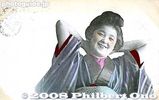
A saucy little Geisha. The pose is good.373 views
|
|

Patriotic Maiko. Card designed to encourage soldiers on the front line. Notice that her sleeves are so long that you can see her right sleeve touch the ground. That's the kimono of a maiko. This is a modern postcard reproduction.373 views
|
|
|
|

After a bath. That's what it looks like. She was another very photogenic woman.370 views
|
|

Cheek-to-Cheek. One of my favorite postcards. I wonder if they were sisters. Real-photo postcard with no divided back. The actual card is more yellowed, but I bleached it with Photoshop.369 views
|
|

Smiling Maiko Standing. Great smile. This is the same woman in the card where two maiko are holding the Japanese flag.366 views
|
|

Laughing Geisha with cowboy hat & cigar. This must be the most humorous pose she created. Those tourists must've gotten a big kick when they saw this card. A geisha from the wild, wild West. Even today, it elicits an affectionate laugh. One of my363 views
|
|

Laughing Geisha with umbrella. The sender probably wrote about his incredible adventures in Japan. Postmarked 1904 from Yokohama addressed to Hamburg, Germany. The actual card is more yellowed and almost brown, but I bleached it with Photoshop.362 views
|
|

Bride arrives at the groom's house.362 views
|
|

Teruha sitting.361 viewsHer name was Teruha and she appeared in many postcards. She's probably still in her teens in this photo. She was born in 1896 in Osaka and worked as a geisha in Shimbashi, Tokyo before becoming a Buddhist priest in Kyoto. Read more about her interesting life by James A. Gatlin at geikogallery.com.
|
|

Maiko hair ornaments. Maiko have more ornaments in their hair than geisha do. The hair ornaments differ depending on the current season. They usually have a flower motif, and if you look closely and see what flower it is, you can tell what season it is.357 views
|
|

Rear and side views. Nice side and back shot of a kimono woman. Can't see any wedding ring, but she looks married.356 views
|
|
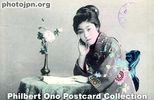
Flower in Vase. Nicely composed photograph. With a serene-looking face, she's an ideal postcard model. She also appears in the next postcard.351 views
|
|

Her affable and infectious smile made her stand out during a time when most people posing for a photograph did not smile.340 views
|
|

Dancing woman339 views
|
|
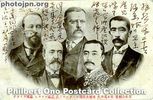
Russo-Japan Peace Conference representatives. Left to right: Russian Finance Minister Count Sergei Witte, Baron Rosen, US President Theodore Roosevelt, Japanese Ambassador to the US Kogoro Takahira, and Japanese Foreign Minister Jutaro Komura.336 viewsIt was a time when nations jostled for territory and trade. The Russo-Japanese War of 1904-05 was waged mainly for the control of Manchuria and Korea. The US fully supported Japan and hoped that Japan would keep Korea open to all nations for commerce. The war started before it was declared with Japan launching a surprise attack to destroy part of the Russian fleet at Port Arthur in Manchuria and landing troops in Korea. The US and Great Britain cheered Japan. The US assumed that Japan would open up Asian markets. President Theodore Roosevelt believed that Japan was fighting Russia for America. But then, he also feared that if Japan won the war, there might be a struggle between the US and Japan in the future.
In the famous Battle of the Sea of Japan on May 27-28, 1905, Japan astonishingly defeated the Russian fleet which had sailed from the Baltic Sea eighteen months before. Even before this battle, Japan was financially drained and asked Roosevelt to mediate an end to the war. Although Japan was winning the war, they were outnumbered by the Russians who had the troops and resources to keep fighting. The Russian czar, however, finally relented after seeing his Baltic fleet destroyed.
A peace conference was held at Portsmouth, New Hampshire in July and Aug. 1905. The principle representatives are pictured in the postcard above. The caption on the bottom of the card identifies these men. The Japanese handwriting in-between is only correspondence and not part of the original postcard which has a postmark dated Aug. 30, 1905.
Harvard-educated Jutaro Komura was a star in Japan's Foreign Ministry and a successful diplomat in Washington DC and Peking. He was in favor of obtaining control in both Manchuria and Korea. Komura also was instrumental in having Japan form an alliance with Great Britain in 1902. This move further strengthened Japan's position vis-a-vis Russia. Anybody attacking Japan would also have to face the British who had the world's largest navy.
Count Sergei Witte created the Trans-Siberian railway and he was highly respected by the US.
For mediating peace between Japan and Russia, President Roosevelt went on to become the first American to win the Nobel Peace Prize in 1906.
|
|

Woman and cherry blossoms. Unfortunately, she's too hunchbacked in this picture.332 views
|
|

Calligraphy on a folding fan.330 views
|
|

Bride leaving her house vis rickshaw.321 views
|
|

Smiling Maiko sitting in garden320 viewsNotice her left sleeve reaching the ground. A sign of a maiko's kimono, not a geisha's. Also, the high clogs that she wears are called pokkuri. Maiko wear them, but geisha do not.
|
|

The maiko uses her real hair, not a wig. When her hair is down, it reaches her chest.319 views
|
|

Girl with Bouquet. Would've been a great shot if she had smiled.313 views
|
|

Laughing Maiko. Another card to cheer up the men at the front line.304 views
|
|
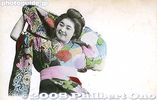
Her name has been a mystery, but I have come across hard evidence that she was a geisha named "Tokimatsu." But I will forever call her the "Laughing Geisha."303 views
|
|

Another shot of her picking tea leaves.302 views
|
|

Drawing water from a well.297 views
|
|

Woman and flower patch. Same woman as in the preceding postcard.295 views
|
|

Laughing Geisha in the rain. There's a horse in the background. Maybe she's watching a parade. The ground looks wet.292 views
|
|

Girl at fence. Her posture is crooked, but somehow this photo looks nice. She's not sensationally attractive, but she's photogenic and comes across well. She also appears in the preceding postcard.286 views
|
|

"Japs" on hand-painted Mt. Fuji card. The message on this card reads: "Fujiyama, the mt. (mountain) the Japs worship. Been seeing Yokohama in a jinrichisha (rickshaw). Feb. 14."285 viewsThis person apparently learned a few Japanese words like "jinrikisha" which means "human-powered vehicle" that is the rickshaw. And the term "Japs" has been around well before World War II.
|
|

Laughing Geisha with fan. There are two Yokohama postmarks on this card. One in Japanese (over the stamp) and one in English. The actual card is more yellowed and almost brown, but I bleached it with Photoshop.283 viewsThere are two Yokohama postmarks on this card. One in Japanese (over the stamp) and one in English. Japanese postmarks have the date in the Year-month-day format. And English postmarks have it in the Day-month-Western year format. As you may know, Japan bases its years on the Emperor's reign. In the Japanese postmark, you can see "36" for the year. That's not 1936, but Meiji 36 that corresponds to 1903. Besides the Meiji Period (1868-1912), there's the Taisho Period (1912-1926) and the Showa Period (1926-1989). Since the Japanese postmark only indicates the last two digits of the year, it can be a pain to figure out which period the year belongs to. In most cases, we can figure it out with the stamp or type of postcard back.
|
|

Woman with flowers. She's wearing two rings on her left hand. She looks like a wife alright. How can you tell? Well, her kimono has a plain design, and the word "married" is written on her face.275 views
|
|
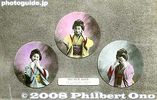
See, hear, nor speak no evil.272 views
|
|

Laughing Geisha with baby. She's nicely posed, and you can even see the baby's face. But the color of her kimono is somewhat drab. A mother (or married woman) does not and need not wear a colorful kimono.269 views
|
|
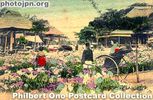
Iris Garden at Horikiri, Tokyo. This card is made of balsa wood. It shows a woman arriving at the garden in a rickshaw. I've seen this photo printed on paper postcards as well. The garden still exists in Tokyo and it's still famous for irises.259 viewsSee photos of the garden today. It's still famous for irises that bloom in June. Hand-colored postcard.
|
|
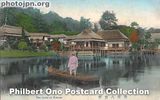
Tea house garden in Hikone, Shiga. This cozy Japanese garden has tea houses. It is directly behind Hikone Castle in Shiga Prefecture. Hikone Castle was the home of Naosuke Ii, the high official who met Commodore Perry.249 viewsToday, this garden still looks pretty much the same. It was even used for a garden scene in the TV mini-series "Shogun." See photos here.
|
|

243 views
|
|

Laughing Geisha looking out. The card is postmarked 1903 from Yokohama. The actual card is more yellowed and almost brown, but I bleached it with Photoshop.241 views
|
|
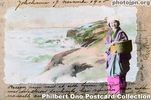
Laughing Geisha on Shore. It's kind of strange to see her at the beach but dressed to pick tea leaves. The message on this postcard was written in French, dated 1905.241 views
|
|
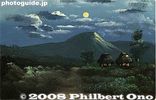
241 views
|
|
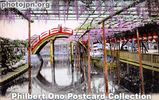
Kameido Tenmangu Shrine, Tokyo. Famous since the Edo Period for wisterias, this shrine has been a popular subject for woodblock artists and early photographers. The wisterias bloom around late April. The shrine is near Kameido Station on the Sobu Line.241 viewsThe shrine is near Kameido Station on the Sobu Line in Tokyo. Hand-colored.
|
|
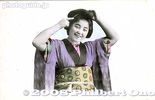
Combing her hair.238 views
|
|

Oil-painted card of Mt. Fuji 2. Another postcard oil painting of Mt. Fuji.237 views
|
|
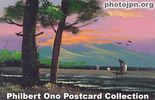
Painting by high school girl? This is my only oil-painted card that has a message and postmark (1910 from Nagasaki). It was addressed to a lady in Alameda, California and says in English that the card was hand painted by a Japanese high school girl.236 viewsWhether this is true or not, I don't know. But the painting style of this card and the others you see here are the same. (I bought them as a set.)
|
|
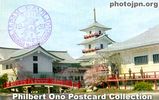
Japan Pavilion at Golden Gate International Expo, 1939. In 1939, the Golden Gate International Exposition was held in San Francisco, California's Treasure Island from February 19, 1939 to October 29, 1939. The expo theme was "Pageant of the Pacif231 viewsPacific Rim countries participated with pavilions having distinctive architecture, landscape, and art. The Japan Pavilion looked quite elaborate with a pagoda, Japanese-style bridge, and two large temple-like buildings.
It was a peaceful gathering of nations and it's sad that only two years later, Japan and America were at war with each other.
|
|
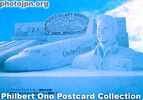
1993 Sapporo Snow Festival. In Sept. 1992, US-Japan relations literally reached new heights with Mamoru Mohri becoming the first Japanese to fly on a US Space Shuttle.229 viewsOn board the Endeavor, Mohri worked on numerous Skylab experiments as a payload specialist during the eight-day mission. He even conducted a "space classroom" with kids in Japan via a live TV broadcast.
This postcard shows the snow sculptures of the Space Shuttle Endeavor, the mission's patch, and a bust of Mohri built for the 44th Sapporo Snow Festival held in Feb. 1993 in Sapporo, Hokkaido. On the left side of the sculpture, you can see ice slides for children.
|
|
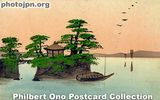
Oil-painted card of Matsushima. Matsushima is a picturesque group of pine tree islands near Sendai, Miyagi Pref. The island pictured is one of the main islands and a major tourist stop.229 viewsAlong with Amanohashidate in Kyoto and Miyajima in Hiroshima, Matsushima is known as one of the three most famous views of Japan (Nihon Sankei).
|
|
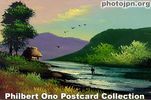
Oil-painted card of river. Apparently by the same artist as the preceding card.205 views
|
|
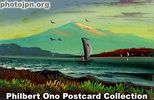
Oil-painted card of ocean and mountain. Apparently by the same artist as the preceding card.204 views
|
|

Laughing Geisha on terrace. It looks like she's on the veranda of a restaurant along a river. If she's a Kyoto geisha, it would be the Kamo River. But these cards were made in Yokohama. I wonder if she was from Yokohama.195 views
|
|
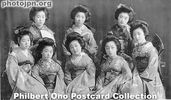
Young girls in kimono.194 views
|
|
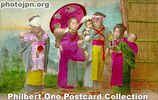
Young baby sitters. The girls look around 8 or 9 years old. The artist went slightly overboard with the hand coloring. Colorful, but too bold.189 views
|
|
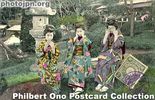
Speak, Hear, and See No Evil. A common pose imitating the monkeys. Postmarked 1914. Hand-colored.178 views
|
|
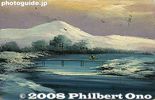
175 views
|
|
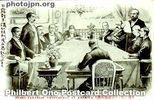
Russo-Japan Peace Conference at Portsmouth. The Japanese delegation headed by Jutaro Komura is on the left and Count Sergei Witte leads the Russian delegation on the right side of the table. The room apparently had a nice view of the ocean.160 viewsAlthough President Roosevelt did not attend the peace conference at Portsmouth, he supervised every detail from Washington and his home on Long Island. Komura was instructed by Tokyo to make sure to obtain a free hand in Korea and control of Southern Manchuria and the railway. Also, for the frosting on the cake, to obtain an indemnity and all of Sakhalin. Japan was in dire financial straits and needed the indemnity to pay for the war and have enough capital for projects in Korea and Manchuria.
Komura got his demands for controlling Korea and Manchuria, but Count Witte rejected demands for an indemnity and Sakhalin. Komura then threatened to walk out of the conference. However, Tokyo told him to compromise. Komura offered to give up on the indemnity if Russia left Sakhalin. Witte accepted and Japan got the southern half of Sakhalin. The Treaty of Postsmouth was signed in Sept. 1905. However, when the Japanese people back home found out that there would be no indemnity, anti-peace rioting occurred. Mobs surrounded the US legation in Tokyo. Komura feared for his life when he returned to Japan.
|
|
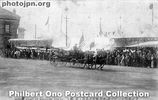
Welcome Parade for the American Fleet. The fleet's crew enjoyed a few days in Japan and was given the red-carpet treatment. A welcoming parade was given in downtown Tokyo around Shimbashi (pictured above) and Hibiya Park.160 viewsA large turnout is apparent in this photo showing a horse-drawn carriage carrying the US and Japanese flags.
American crewmen held Japanese paper umbrellas with a star design, while the Japanese and American flags were everywhere. Japan was highly in favor of peaceful relations with the U.S. The American sailors were surprised and delighted by the friendliness and hospitality of the Japanese.
|
|
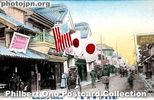
Benten-dori street in Yokohama.158 views
|
|
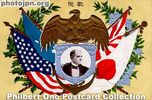
"Great White Fleet" Visiting Japan in Oct. 1908. On Dec. 16, 1907, sixteen U.S. battleships departed Hampton Roads, Virginia for a historic tour around the world. President Theodore Roosevelt was on hand to see the fleet off.157 views"Great White Fleet" Visiting Japan in Oct. 1908. On Dec. 16, 1907, sixteen U.S. battleships departed Hampton Roads, Virginia for a historic tour around the world. President Theodore Roosevelt was on hand to see the fleet off. Dubbed the "Great White Fleet" because of the white-painted hulls of the ships, the powerful flotilla's mission was to promote goodwill and to show any potential enemy (especially Japan) the U.S. Navy's vast naval power.
The fleet was first commanded by Rear Admiral Robley "Fighting Bob" Evans. He later fell ill and was replaced by Rear Admiral Charles Sperry. The person pictured in the postcard is Sperry. A series of postcards were issued by Japan's Department of Communications in commemoration of the fleet's visit to Japan (Yokohama). The card above and below are from this series. The kanji characters above the eagle's head reads "Kangei" which means welcome.
|
|

Child dancer. Postcard-size photograph. Date is unknown.147 views
|
|

U.S.S. Mississippi. This was one of the four "black ships" in Commodore Perry 's fleet when he first visited Japan in 1853. This postcard was made to commemorate the construction (in 1901) of the monument (see next postcard) marking Perry�146 viewsU.S.S. Mississippi. This was one of the four "black ships" in Commodore Perry 's fleet when he first visited Japan in 1853. This postcard was made to commemorate the construction (in 1901) of the monument (see next postcard) marking Perry's first landing in Tokyo Bay.
|
|
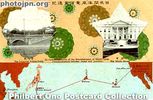
Japan-America Cable Route. With a crudely drawn map, this card shows the route of the undersea cable between Japan and America.146 viewsThe cable extended across the Pacific Ocean via the Bonin Islands (Ogasawara Islands), Guam, Midway, and Hawaii. The cable also connected Japan with the Philippines and Shanghai, China.
On the upper half the card, you see the Imperial Palace on the left and the White House on the right. The caption at the center of the card reads, "In Commemoration of the Establishment of Direct Cable Communication between Japan and America." It's sad to think that these two friendly nations went to war with each other a few decades later.
|
|

Pictured here is one of the U.S. battleships in the fleet. The words "American Fleet" are also spelled out by the anchor rope along the bottom of the photo. The Amphitrite, Puritan, and Montgomery were among the ships making the tour.143 viewsWelcome American Fleet, Oct. 1908
After leaving the U.S., the fleet cruised around South America's Cape Horn, up the U.S. West Coast to San Francisco, across the Pacific Ocean to Hawaii, visited Australia and New Zealand, then stopped in Yokohama, Japan on Oct. 18-24, 1908. Then the fleet sailed across the Indian Ocean, the Suez Canal, the Mediterranean, and the North Atlantic ocean before returning triumphantly to Hampton Roads, Virginia on Feb. 22, 1909. President Roosevelt was there to greet the return of his proud Great White Fleet. It was a 46,000-mile cruise.
It's interesting to note that as a means of long-distance transportation, ships were much more advanced than anything else. Ford's Model T was built in 1908, and the Wright Brothers sold their first flyer (a one-seater) to the U.S. Army in 1909 after a dazzling and record-breaking flight time of 1 hour and 20 min. (altitude: 300 feet).
|
|

Twins. They look like twins or sisters. Real-photo postcard postmarked 1918.141 views
|
|

Cherry Blossoms, Potomac Park, Washington, DC. In this postcard, the Bureau of Engraving and Printing and the U.S. Capitol Dome are in the background. This card was made in the USA in the late 1930s or early 1940s.137 viewsThe cherry trees must be the prettiest and most appreciated gift Japan has ever presented to the United States. The trees are truly a national treasure, for both countries. Today, there are over 3,700 cherry trees accenting Potomac Park and the Washington Monument. They are carefully maintained by arbor specialists.
|
|

Rickshaw ride in Yokohama. The caption reads "Navy Musicians enjoying a Rickasha Ride in Yokohama, Japan." Since the card was printed by an American publisher, I'm assuming that they are Americans.136 views
|
|

Autographed as Yoko Aozora. She must have been some kind of teenaged entertainer. Probably a dancer. Looks charming enough.133 views
|
|

128 views
|
|
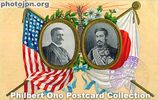
Opening of the Japan-America Cable. This postcard is one of a series of cards which commemorated the opening of the undersea communications cable between Japan and America on Aug. 1, 1906. The head of state and flags of both countries are shown.127 viewsOn the left is US President Theodore Roosevelt and on the right is Emperor Meiji.
|
|

New Year's photo. The paper ball is for a traditional New Year's game. Postcard-size photograph.124 views
|
|
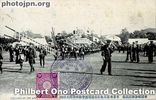
Welcome Parade for the American Fleet (Hibiya Park)122 views
|
|
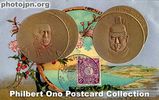
Commodore Perry and Naosuke Ii (embossed). This is another postcard issued in 1909 to commemorate the 50th anniversary of the opening of Yokohama Port. It has a commemorative postmark marking the "Jubilee of Opening of Yokohama Port."120 viewsYokohama Port was officially opened to foreign trade on July 1, 1859 in accordance with the US-Japan Treaty of Amity and Commerce.
Also see the caption for the preceding postcard.
|
|

Girl on stage. Postcard-size photograph. Date is unknown.118 views
|
|

Welcome Parade for the American Fleet (back). The back of the postcard (see preceding postcard) had a note talking about the American Fleet's visit to Tokyo. Postmarked Oct. 21, 1908.112 viewsNotice that the dividing line is not at the center of the card. Two-thirds of the card was for the recipient's address and only one-third was for the message. Cards like this with off-center dividers were published between March 28, 1907 and March 1, 1918 when the divider was moved to the center of the card. Before March 28, 1907, there was no divider on the back and only the recipient's address could be written. The message had to be written on the picture side which usually had a large white space for writing. Looking at the back of the postcard for the divider is another way to find out the approximate date of the card.
|
|
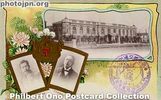
Japan-America Cable by Communications Department. Another postcard marking the cable's opening. This card was issued by Japan's Communications Department (building pictured) that was in charge of the postal system. On the right is the Comm. Minist105 viewsThe commemorative rubber stamp says "Congratulation for the Opening of the Japan-America Cable" and shows a map of the cable route and the US and Japanese flags.
|
|
|
|